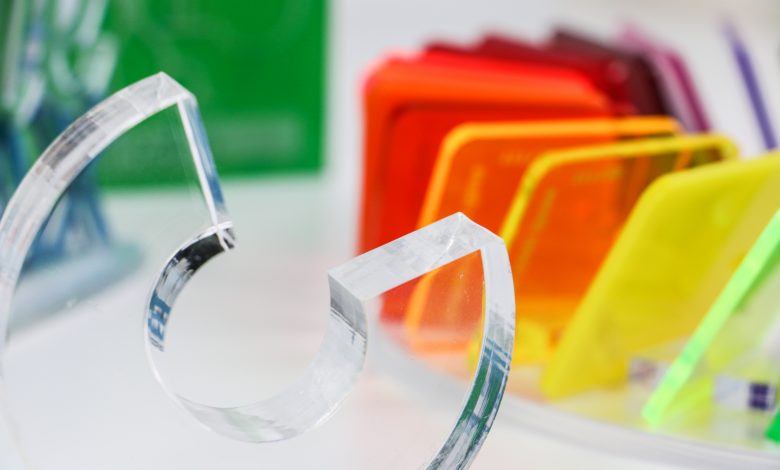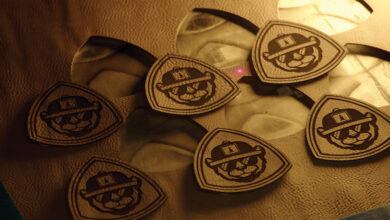When it comes to the perfect substrate to use in your laser engraver, you can make a very good argument for acrylic because of its versatility when it comes to color, texture and shape, as well as its ease of use.
Acrylic is one of the easiest materials to laser engrave, but if the person doing the engraving doesn’t know the best settings for the substrate they are working with, the laser can do some unintended damage.
Acrylic is used to make everything from ADA, architectural and industrial signage to trophies, plaques, donor walls, executive gifts and promotional items.
Bobbi Payne, technical specialist at Rowmark, says that acrylics serve a very broad market and that her company is seeing more and more in-home and office décor made from it with the different textures and colors available.
“I think the easiest way to mess up a project is simply not being familiar with your equipment or the substrate you are trying to engrave,” says Payne, “because no two machines are just alike.”
The key is to “test, test and then test again,” she says, before starting work on a client order.
“The thing that causes the most problems is people trying to use too high of power and they stress the material. In other words, they apply too much heat to it and it will begin to soften and melt or warp,” she adds.
Most laser and rotary engravers come with general guidelines about how to engrave specific materials and the material manufacturers themselves, like Rowmark, also include general guidelines, but the best way to zero in on the best machine settings for a particular type of substrate is to practice using different settings each time.
Payne recommends making adjustments in 5-watt increments.
“You can always run a second path but once you’ve gone too deep, you’ve gone too deep. Or once you have stressed it too much, exposed it to too much heat and warped it, then you are starting out with new material again,” she says.
Payne adds that “burning it hotter doesn’t have an effect on running time, whereas the lower power settings burn shallower, so depending on the material you are using too little power will sacrifice detail. The combination is you need to find the sweet spot between power setting, speed setting and your dpi.”
Amie McGee, director of operations at Trotec, says that “if you are trying to get depth, make sure you don’t get too much depth in one pass. Do multiple passes.”
Part of the problem is that laser engraving acrylic creates a lot of dust and if too much heat is put into the acrylic, the edges will get cloudy. McGee recommends lowering the heat and making multiple passes.
If the engraver uses too much power and too slow of a speed, the material can burn or cause warp. To minimize banding, adjust the dots per inch on your graphic, says Payne. She recommends using 400 dpi.
“That seems to be the sweet spot where you get a nice, smooth, consistent engraving without going too deep. It just gives you a clean, crisp engraving, particularly when doing standard size fonts or larger fonts and pictograms,” she adds.
Payne recommends that shops refocus the lens on their laser for every project. “Running a job out of focus can pretty easily result in flaming or melting,” she says.
There are two types of acrylic: cast and extruded. Cast acrylics are more brittle but they have a glassy appearance to them, says Payne. They are also more decorative. Rowmark manufactures extruded acrylic. Most of its pieces are two-ply, meaning they are made up of two different colors so that when the top layer is engraved off, another color rests beneath.
Engraving on this type of material can be done using laser, rotary or CNC engravers, she says.
Mike Dean, vice president of sales and marketing for Epilog Laser in Golden, Colorado, says that cast acrylic gives an engraving a nice frost but it is harder to cut than extruded acrylic so people tend to use the different types of acrylic for different purposes.
“The cast is great for engraving and extruded is good for cutting because of their different melting points,” he says.
When engraving acrylic, Dean recommends taking the laser out of focus because the raster lines can become apparent when engraving cast acrylic.
If you take your lens out of focus by 1/16 or 1/8 of an inch, it makes the laser’s spot size larger which then has more overlap with each line, making a nice smooth surface, he says. “If you are perfectly in focus, a lot of times you will be able to resolve each individual raster line.”
He adds that if you take the lens out of focus by 1/16 of an inch, “you are not going to lose much in the way of detail and you’ll only start losing detail in really fine detailed objects, but they have to be pretty small details before you start to notice them.”
Running acrylic through the laser at high speed but low power gets the frosted look most people are looking for in an engraving.
“It doesn’t take much energy to mark it. You tend to overcook it if you do high power. Then it starts to make sort of a mess,” Dean says.
Print to cut is a very popular use for acrylic, he says. The design is printed on the back side of the acrylic and then the shape is cut out with a laser.
To cut acrylic, the laser needs to be set on full power and slow speed, which is the opposite of engraving. There are more ways for the end product to be damaged during the actual cutting process, Dean says.
“You are melting the acrylic and that melting, once it cools, it solidifies and creates a really nice, clear or polished edge. If you melt it a little bit more it tends to look nicer,” Dean says.
The acrylic can catch on fire because it is made from a byproduct of oil.
“If you are applying a lot of heat to it, which is what the laser does, and you don’t have air assist on, the acrylic will start on fire and that can damage your machine,” he says. “If you aren’t paying attention it can get away from you.”
That’s why most laser engravers now have air assist built into them. Air assist moves the combustible gases away from the laser beam as acrylic is being cut and makes it less likely the substrate will catch on fire.
Some people attach a nitrogen tank to their machines. Nitrogen isn’t flammable like oxygen, so when it is added to the mix, it helps keep the flames down.
Most acrylic is used to engrave plaques and awards. The vast majority of cutting acrylic is used for signage, Dean says, where they are cutting out letters or parts of logos to hang on a wall either inside or outside of a building.
Dean also recommends that shops use a longer focal length lens when cutting acrylic. The standard lens is 2 inches, but when cutting thicker acrylic, it helps to use a 4-inch or 5-inch lens which helps the laser beam stay straighter longer.
Trotec’s McGee agrees that choosing the correct focus lens is important. When cutting through anything ¼-inch to ¾” thick, she recommends using a 2.5″ lens. “That gives you the ability to focus, the focal depth and focal tolerance to focus into the material a bit so as you cut through the acrylic it is still a nice straight cut through.”
A shorter lens would get out of focus at the bottom.
She adds that shops should make sure they have the appropriate laser wattage for the thickness of the material they want to cut. She suggests 30W of power for every 1/8-inch of thickness, which “gives you good production speed and allows you to get a nice edge quality.”
Another tip is to make sure your laser engraver has a good vacuum beneath the material when cutting acrylic. “You want to have that melt come down through the cut curve to give you a flame-polished edge. A good exhaust system and vacuum underneath will help with the quality,” McGee says.
Sometimes tick marks or marring appear on the surface of the acrylic during engraving. The way to avoid that happening is to raise the acrylic off the table so that when the laser gets through the cut curve it doesn’t bounce back into the back side of the acrylic.
“People get creative with that, how they raise it up, whether they use coins or little wood pieces,” says McGee.
There is a difference between the settings used for a separation cut and one that produces a quality flame-polished edge, says McGee.
“If you are just cutting things out, you can go faster. When you are looking at a flame-polished edge, go a bit slower to have that material melt in the proper way to give you a flame-polished edge,” she says.
If the edge starts to look frosted at the top of the cut, it means there is too much air assist. The air mixing into the acrylic creates the frosted look.
One way to avoid getting a frosted look around the edges of your engraving is to engrave through the low-tack paper tape or paper mat that is pasted over the acrylic to protect it from scratches, she says.
Some of the material Trotec manufactures comes with a laserable plastic mat over the top of it to protect it. The plastic mat keeps the dust down and protects the surface of the acrylic.
Rowmark’s Payne always recommends that customers remove the protective masking from the acrylic sheet before raster engraving it.
“They think they can burn right through that and in doing that it will protect the rest of the sheet during the fabrication process. What you end up with is a melted mess,” she says. “They can vector cut the edges or shapes with the masking in place but you always need to remove it before you raster engrave text or pictures. Otherwise it melts into what you are trying to engrave.”
She adds that having patience is very important. It takes time to fine-tune a laser and to understand its many nuances. It also is imperative that all of the equipment used is well-maintained and kept clean and sharpened.
“All those things are going to offer you the best longevity, not only for the equipment but the results you are fabricating,” Payne says.







